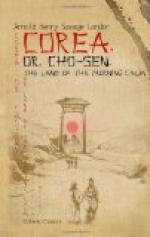Let us now see what a Corean household is like. But, first, as to the matter of house architecture. Here there is little difference to be observed between the house of the noble and that of the peasant, except that the former is generally cleaner-looking. The houses in Corea may be divided into two classes—those with thatched roofs of barley-straw, and those with roofs of tiles, stone and plaster. The latter are the best, and are inhabited by the well-to-do classes. The outside walls are of mud and stone, and the roof, when of tiles, is supported by a huge beam that runs from one end of the house to the other. The corners of the roof are usually curled up after the Chinese fashion. A stone slab runs along the whole length of the roof, and is turned up at the two ends, over the upper angle of the roof itself. The tiles are cemented at the two sides of this slab, and likewise at the lower borders of the roof. The windows, again, are rectangular and are placed directly under the roof, being in consequence well protected from the rain.
Corean houses are never more than one storey high. The houses of officials and rich people are enclosed by a wall of masonry, the gate of which is surmounted by a small pagoda-like roof. In the case of the houses of great swells, like generals and princes, it is customary to have two and even three gates, which have to be passed through in succession before the door of the house is reached. The outer wall surrounding the compound is seldom more than six or eight feet high, and, curiously enough, all along the top of the wall runs a narrow roof, the width of two tiles. This, besides being a sort of ornament, is of practical use in protecting it from the damp.
One cannot call the Coreans great gardeners, for they seem to take comparatively little interest in the native flora. The richer people do, as a rule, have small gardens, which are nicely laid out with one or two specimens of the flowers they esteem and care to cultivate; but really ornamental gardens are few in number in the Land of Cho-sen. Kitchen gardens naturally are frequently found, even near the houses of the poorer people.
One peculiarity, which characterises the majority of Corean houses of the better sort is that they are entered by the windows; these being provided with sliding latticed frames covered with tissue paper, and running on grooves to the sides, like the Shojis of Japan. The tissue paper is often dipped in oil previous to being used on the sliding doors and windows, as it is then supposed to keep out the cold better than when left in its natural state. As the doors and windows of Cho-sen, however, very seldom have the quality of fitting tight, a Corean house is therefore quite a rendezvous for draughts and currents of air.




